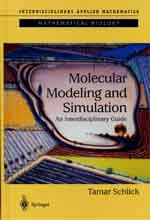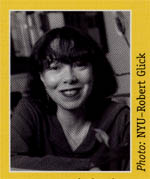 introduces :
introduces :Tamar Schlick
Molecular Modeling and Simulation - An Interdisciplinary Guide.
Springer, New York, 2002
ISBN 0-387-95404-X
EUR 85.00 about $85.00
 introduces :
introduces :
From the book cover, rear:
INTERDISCIPLINARY APPLIED MATHEMATICS
MATHEMATICAL BIOLOGY
This book evolved from an interdisciplinary graduate course entitled Molecular Modeling developed at New York University. Its primary goal is to stimulate excitement for molecular modeling research while pro- viding grounding in the discipline. Other scientists who wish to enter, or become familiar with, the field of biomolecular modeling and Simu- lation may also benefit from the broad coverage of problems and approaches. The book surveys three broad topics: (a) biomolecular structure and modeling—current problems and state of computations; (b) molecular mechanics—force field origin, composition, and evaluation tech- niques; and (c) simulation techniques—conformational sampling by geometry optimization, Monte Carlo, and molecular dynamics approaches. |
 |
Contents:
1.1 A Multidisciplinary Enterprise
1.1.1 Consilience
1.1.2 What is Molecular Modeling
1.1.3 Need For Critical Assessment
1.1.4 Text Overview
1.2 Molecular Mechanics
1.2.1 Pioneers
1.2.2 Simulation Perspective
1.3 Experimental Progress
1.3.1 Protein Crystallography
1.3.2 DNA Structure
1.3.3 Crystallography
1.3.4 NMR Spectroscopy
1.4 Modern Era
1.4.1 Biotechnology
1.4.2 PCR and Beyond
1.5 Genome Sequencing
1.5.1 Sequencing Overview
1.5.2 Human Genome
Chapter 1 References (Postscript) (PDF)
2 Biomolecular Structure and Modeling: Problem and Application Perspective
2.1 Computational Challenges
2.1.1 Bioinformatics
2.1.2 Structure From Sequence
2.2 Protein Folding
2.2.1 Folding Views
2.2.2 Folding Challenges
2.2.3 Folding Simulations
2.2.4 Chaperones
2.2.5 Unstructured Proteins
2.3 Protein Misfolding
2.3.1 Prions
2.3.2 Infectious Proteins?
2.3.3 Hypotheses
2.3.4 Other Misfolding Processes
2.3.5 Function From Structure
2.4 Practical Applications
2.4.1 Drug Design
2.4.2 AIDS Drugs
2.4.3 Other Drugs
2.4.4 A Long Way To Go
2.4.5 Better Genes
2.4.6 Designer Foods
2.4.7 Designer Materials
2.4.8 Cosmeceuticals
3 Protein Basic
3.1 The Machinery of Life
3.1.1 From Tissues to Hormones
3.1.2 Size and Function Variability
3.1.3 Chapter Overview
3.2 The Amino Acid Building Blocks
3.2.1 Basic C Unit
3.2.2 Essential and Nonessential Amino Acids
3.2.3 Linking Amino Acids
3.2.4 The Amino Acid Repertoire
3.3 Sequence Variations in Proteins
3.3.1 Globular Proteins
3.3.2 Membrane and Fibrous Proteins
3.3.3 Emerging Patterns from Genome Databases
3.3.4 Sequence Similarity
3.4 Protein Conformation Framework
3.4.1 The Flexible phi and psi and Rigid omega Dihedral Angles
3.4.2 Rotameric Structures
3.4.3 Ramachandran Plots
3.4.4 Conformational Hierarchy
4 Protein Hierarchy
4.1 Structure Hierarchy
4.2 Helices: A Common Secondary Structural Element
4.2.1 Classic - Helix
4.2.2 310 and Helices
4.2.3 Left - Handed - Helix
4.2.4 Collagen Helix
4.3 - Sheets: A Common Secondary Structural Element
4.4 Turns and Loops
4.5 Formation of Supersecondary and Tertiary Structure
4.5.1 Complex 3D Networks
4.5.2 Classes in Protein Architecture
4.5.3 Classes are Further Divided into Folds
4.6 - Class Folds
4.6.1 Bundles
4.6.2 Folded Leafs
4.6.3 Hairpin Arrays
4.7 - Class Folds
4.7.1 Anti - Parallel Domains
4.7.2 Parallel and Antiparallel Combinations
4.8 / and + - Class Folds
4.8.1 / Barrels
4.8.2 Open Twisted / Folds
4.8.3 Leucine-Rich / Folds
4.8.4 + Folds
4.9 Number of Folds
4.9.1 Finite Number?
4.9.2 Concerted Target Selection: Structural Genomics
4.10 Quaternary Structure
4.10.1 Viruses
4.10.2 From Ribosomes to Dynamic Networks
4.11 Structure Classification
5 Nucleic Acids Structure
5.1 DNA, Life's Blueprint
5.1.1 The Kindled Field of Molecular Biology
5.1.2 DNA Processes
5.1.3 Challenges in Nucleic Acid Structure
5.1.4 Chapter Overview
5.2 The Basic Building Blocks of Nucleic Acids
5.2.1 Nitrogenous Bases
5.2.2 Hydrogen Bonds
5.2.3 Nucleotides
5.2.4 Polynucleotides
5.2.5 Stabilizing Polynucleotide Interactions
5.2.6 Chain Notation
5.2.7 Atomic Labeling
5.2.8 Torsion Angle Labeling
5.3 Nucleic Acid Conformational Flexibility
5.3.1 The Furanose Ring
5.3.2 Backbone Torsional Flexibility
5.3.3 The Glycosyl Rotation
5.3.4 Sugar/Glycosyl Combinations
5.3.5 Basic Helical Descriptors
5.3.6 Base - Pair Parameters
5.4 Canonical DNA Forms
5.4.1 B-DNA
5.4.2 A-DNA
5.4.3 Z-DNA
5.4.4 Comparative Features
6 Topics in Nucleic Acids Structure
6.1 Introduction
6.2 DNA Sequence Effects
6.2.1 Local Deformations
6.2.2 Orientation Preferences in Dinucleotide Steps
6.2.3 Intrinsic DNA Bending in A-Tracts
6.2.4 Sequence Deformability Analysis Continues
6.3 DNA Hydration and Ion Interactions
6.3.1 Resolution Difficulties
6.3.2 Basic Patterns
6.4 DNA/Protein Interactions
Supplement to section 6.4 (Postscript) (PDF)
6.5 Variations on a Theme
6.5.1 Hydrogen Bonding Patterns in Polynucleotides
6.5.2 Hybrid Helical/Nonhelical Forms
6.5.3 Overstretched and Understretched DNA
6.6 RNA Structure
6.6.1 RNA Chains Fold Upon Themselves
6.6.2 RNA's Diversity
6.6.3 RNA at Atomic Resolution
6.6.4 Emerging Themes in RNA Structure and Folding
6.7 Cellular Organization of DNA
6.7.1 Compaction of Genomic DNA
6.7.2 Coiling of the DNA Helix Itself
6.7.3 Chromosomal Packaging of Coiled DNA
6.8 Mathematical Characterization of DNA Supercoiling
6.8.1 DNA Topology and Geometry
6.9 Computational Treatments of DNA Supercoiling
6.9.1 DNA as a Flexible Polymer
6.9.2 Elasticity Theory Framework
6.9.3 Simulations of DNA Supercoiling
7 Theoretical Approaches
7.1 The Merging of Theory and Experiment
7.1.1 Exciting Times for Computationalists!
7.1.2 The Future of Biocomputations
7.1.3 Chapter Overview
7.2 QM Foundations
7.2.1 The Schrodinger Wave Equation
7.2.2 The Born-Oppenheimer Approximation
7.2.3 Ab Initio
7.2.4 Semi-Empirical QM
7.2.5 Recent Advances in Quantum Mechanics
7.2.6 From Quantum to Molecular Mechanics
7.3 Molecular Mechanics Principles
7.3.1 The Thermodynamic Hypothesis
7.3.2 Additivity
7.3.3 Transferability
7.4 Molecular Mechanics Formulation
7.4.1 Configuration Space
7.4.2 Functional Form
7.4.3 Some Current Limitations
8 Force Fields
8.1 Formulation of the Model and Energy
8.2 Normal Modes
8.2.1 Characteristic Motions
8.2.2 Spectra of Biomolecules
8.2.3 Spectra As Force Constant Sources
8.2.4 In-Plane and Out-of-Plane Bending
8.3 Bond Length Potentials
8.3.1 Harmonic Term
8.3.2 Morse Term
8.3.3 Cubic and Quartic Term
8.4 Bond Angle Potentials
8.4.1 Harmonic and Trigonometric Terms
8.4.2 Cross Bond Stretch / Angle Bend Terms
8.5 Torsional Potentials
8.5.1 Origin of Rotational Barriers
8.5.2 Fourier Terms
8.5.3 Torsional Parameter Assignment
8.5.4 Improper Torsion
8.5.5 Cross Dihedral/Bond Angle and Improper/Improper Dihedral Terms
8.6 The van der Waals Potential
8.6.1 Rapidly Decaying Potential
8.6.2 Parameter Fitting From Experiment
8.6.3 Two Parameter Calculation Protocols
8.7 The Coulombic Potential
8.7.1 Coulomb's Law: Slowly Decaying Potential
8.7.2 Dielectric Function
8.7.3 Partial Charges
8.8 Parameterization
8.8.1 A Package Deal
8.8.2 Force Field Performance
9 Nonbonded Computations
9.1 A Computational Bottleneck
9.2 Approaches for Reducing Computational Cost
9.2.1 Simple Cutoff Schemes
9.2.2 Ewald and Multipole Schemes
9.3 Spherical Cutoff Techniques
9.3.1 Technique Categories
9.3.2 Guidelines for Cutoff Functions
9.3.3 General Cutoff Formulations
9.3.4 Potential Switch
9.3.5 Force Switch
9.3.6 Shift Functions
9.4 The Ewald Method
9.4.1 Periodic Boundary Conditions
9.4.2 Ewald Sum and Crystallography
9.4.3 Morphing a Conditionally Convergent Sum
9.4.4 Finite-Dielectric Correction
9.4.5 Ewald Sum Complexity
9.4.6 Resulting Ewald Summation
9.4.7 Practical Implementation
9.5 The Multipole Method
9.5.1 Basic Hierarchical Strategy
9.5.2 Historical Perspective
9.5.3 Expansion in Spherical Coordinates
9.5.4 Biomolecular Implementations
9.5.5 New Variants
9.6 Continuum Solvation
9.6.1 Need for Simplification!
9.6.2 Potential of Mean Force
9.6.3 Stochastic Dynamics
9.6.4 Continuum Electrostatics
10 Multivariate Minimization
10.1 Optimization Applications
10.1.1 Algorithmic Understanding Needed
10.1.2 Chapter Overview
10.2 Fundamentals
10.2.1 Problem Formulation
10.2.2 Independent Variables
10.2.3 Function Characteristics
10.2.4 Local and Global Minima
10.2.5 Derivatives
10.2.6 Hessian Matrix
10.3 Basic Algorithms
10.3.1 Greedy Descent
10.3.2 Line Searches
10.3.3 Trust Region Methods
10.3.4 Convergence Criteria
10.4 Newton's Method
10.4.1 Newton in One Dimension
10.4.2 Newton's Method for Minimization
10.4.3 Multivariate Newton
10.5 Large-Scale methods
10.5.1 Quasi-Newton (QN)
10.5.2 Conjugate Gradient (CG)
10.5.3 Truncated-Newton (TN)
10.5.4 Simple Example
10.6 Software
10.6.1 Popular Newton and CG
10.6.2 CHARMM's ABNR
10.6.3 CHARMM's TN
10.6.4 Comparative Performance on Molecular Systems
10.7 Recommendations
10.8 Future Outlook
11 Monte Carlo Techniques
11.1 Monte Carlo Popularity
11.1.1 A Winning Combination
11.1.2 From Needles to Bombs
11.1.3 Chapter Overview
11.1.4 Importance of Error Bars
11.2 Random Number Generators
11.2.1 What is Random?
11.2.2 Properties of Generators?
11.2.3 Linear Congruential Generators
11.2.4 Other Generators
11.2.5 Artifacts Generators
11.2.6 Recommendations
11.3 Gaussian Random Variates
11.3.1 Manipulation of Uniform Random Variables
11.3.2 Normal Variates in Molecular Simulations
11.3.3 Odeh and Evans Method
11.3.4 Box/Muller Method
11.4 Means for Monte Carlo Sampling
11.4.1 Expected Values
11.4.2 Error Bars
11.4.3 Batch Means
11.5 Monte Carlo Sampling
11.5.1 Probability Density Function
11.5.2 Equilibrium or Dynamics
11.5.3 Ensembles
11.5.4 Importance Sampling
11.6 Hybrid MC
11.6.1 MC and MD
11.6.2 Basic Idea
11.6.3 Variants and Other Hybrid Approaches
12 Molecular Dynamics: Basics (Postscript) (PDF)
12.1 Introduction
12.1.1 Why Molecular Dynamics?
12.1.2 Background
12.1.3 MD Chapters Outline
12.2 Laplace's Vision of Newtonian Mechanics
12.2.1 The Dream
12.2.2 Deterministic Mechanics
12.2.3 Neglect of Electronic Motion
12.2.4 Deterministic Mechanics
12.2.5 Neglect of Electronic Motion
12.3 Basics
12.3.1 Following Motion
12.3.2 Trajectory Quality
12.3.3 System Setting
12.3.4 Trajectory Sensitivity
12.3.5 Simulation Protocol
12.3.6 High-Speed Implementations
12.3.7 Analysis and Visualization
12.3.8 Reliable Numerical Integration
12.3.9 Computational Complexity
12.4 The Verlet Algorithm
12.4.1 Position and Velocity Propagation
12.4.2 Leapfrog, Velocity Verlet, and Position Verlet
12.5 Constrained Dynamics
12.6 Various MD Ensembles
12.6.1 Ensemble Types
12.6.2 Simple Algorithms
12.6.3 Extended System Methods
Chapter 12 References (Postscript) (PDF)
13 Molecular Dynamics: Further Topics
13.1 Introduction
13.2 Symplectic Integrators
13.2.1 Symplectic Transformation
13.2.2 Harmonic Oscillator Example
13.2.3 Linear Stability
13.2.4 Timestep-Dependent Rotation in Phase Space
13.2.5 Resonance Condition for Periodic Motion
13.2.6 Resonance Artifacts
13.3 Multiple-Timestep (MTS) Methods
13.3.1 Basic Idea
13.3.2 Extrapolation
13.3.3 Impulses
13.3.4 Resonances in Impulse Splitting
13.3.5 Resonance Artifacts in MTS
13.3.6 Resonance Consequences
13.4 Langevin Dynamics
13.4.1 Uses
13.4.2 Heat Bath
13.4.3 Effect of
13.4.4 Generalized Verlet for Langevin Dynamics
13.4.5 LN Method
13.5 Brownian Dynamics (BD)
13.5.1 Brownian Motion
13.5.2 Brownian Framework
13.5.3 General Propagation Framework
13.5.4 Hydrodynamics
13.5.5 BD Propagation
13.6 Implicit Integration
13.6.1 Implicit vs. Explicit Euler
13.6.2 Intrinsic Damping
13.6.3 Computational Time
13.6.4 Resonance Artifacts
13.7 Future Outlook
13.7.1 Integration Ingenuity
13.7.2 Current Challenges
14 Similarity and Diversity
14.1 Introduction to Drug Design
14.1.1 Chemical Libraries
14.1.2 Early Days
14.1.3 Rational Drug Design
14.1.4 Automated Technology
14.1.5 Chapter Overview
14.2 Database Problems
14.2.1 Database Analysis
14.2.2 Similarity and Diversity Sampling
14.2.3 Bioactivity
14.3 General Problem Definitions
14.3.1 The Dataset
14.3.2 The Compound Descriptors
14.3.3 Biological Activity
14.3.4 The Target Function
14.3.5 Scaling Descriptors
14.3.6 The Similarity and Diversity Problem
14.4 Data Compression and Cluster Analysis
14.4.1 PCA compression
14.4.2 SVD compression
14.4.3 PCA and SVD
14.4.4 Projection Application
14.4.5 Example
14.5 Future Perspectives
Appendix A Syllabus (Postscript) (PDF)
Appendix B Article Reading List
Appendix C General Reference List
Appendix D Homeworks
Bibliography
References